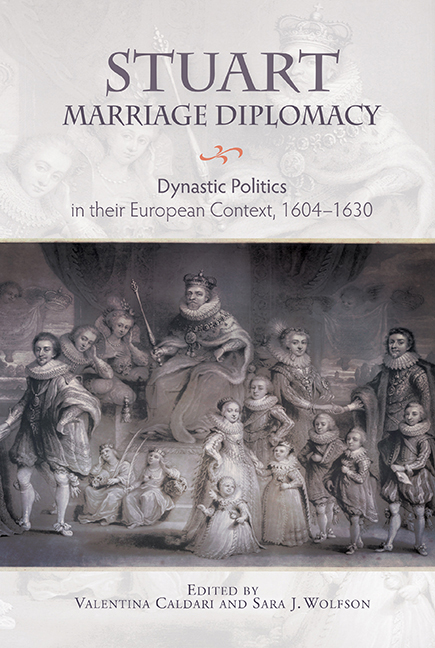Book contents
- Frontmatter
- Contents
- List of Illustrations
- List of Contributors
- Acknowledgements
- List of Abbreviations
- Introduction
- Part One Marriage and the Court
- Part Two Marriage and Politics
- Part Three Marriage and War
- Part Four Marriage and News
- Part Five Marriage and Continental Europe
- Part Six Marriage and Ceremony
- 18 Dynastic Marriage, Diplomatic Ceremonial and the Treaties of London (1604–05) and Antwerp (1609)
- 19 Spanish Architecture in Early Stuart London: Foreign Policy and Architectural Style in Inigo Jones's Queen's Chapel at St James's
- Bibliography
- Index
- Studies in Early Modern Cultural, Political and Social History
19 - Spanish Architecture in Early Stuart London: Foreign Policy and Architectural Style in Inigo Jones's Queen's Chapel at St James's
from Part Six - Marriage and Ceremony
Published online by Cambridge University Press: 24 October 2019
- Frontmatter
- Contents
- List of Illustrations
- List of Contributors
- Acknowledgements
- List of Abbreviations
- Introduction
- Part One Marriage and the Court
- Part Two Marriage and Politics
- Part Three Marriage and War
- Part Four Marriage and News
- Part Five Marriage and Continental Europe
- Part Six Marriage and Ceremony
- 18 Dynastic Marriage, Diplomatic Ceremonial and the Treaties of London (1604–05) and Antwerp (1609)
- 19 Spanish Architecture in Early Stuart London: Foreign Policy and Architectural Style in Inigo Jones's Queen's Chapel at St James's
- Bibliography
- Index
- Studies in Early Modern Cultural, Political and Social History
Summary
On the 28 May 1623 an unusual ceremony took place in the large courtyard of the palace of St James's in Westminister. Don Juan de Mendoza y Velasco, marquess of Hinojosa, extraordinary ambassador of Spain, laid the first stone of a Catholic church: it was the first Catholic church newly built in London in almost a century. The architect was Inigo Jones, surveyor of the king's works, and the building, currently known as the Queen's Chapel, was conceived of as a royal chapel for Infanta Maria Ana of Spain, fiancée of Charles, Prince of Wales. Although at first sight it may look a very simple structure, some original features and the unusual story that lies behind it, make this building a peculiar case for the intersection between international policy, confessional identities and architectural styles.
Inigo Jones, the man who introduced into England the architectural style of the mature Italian Renaissance, especially as influenced by Andrea Palladio, designed a chapel that lacks the most typical features that Renaissance architecture ascribed to a church building. In the treatise The Four Books of Architecture, Palladio suggested ecclesiastical buildings should be adorned with porticoes and columns: ‘Temples must have large porticoes and with more columns than other buildings require.’ These ideas were put into practice in all the most splendid churches in Italy of that time, many of which Inigo Jones had visited. In compliance with this rule, columns were doled out only parsimoniously to the civil buildings designed by Jones, even those commissioned by the royal family. However, in his religious buildings, such as the church of St Paul Covent Garden, or the restauration of St Paul's Cathedral with the construction of a big porch on the façade of the medieval church, they were key protagonists. The only exception was the Queen's Chapel at St James's, where not only columns but also pilasters were avoided. Another feature that became typical of church building following the construction of San Francesco at Rimini by Leon Battista Alberti, was the architectural scheme of the triumphal arch applied to church façades. On the north transept front of St Paul's Cathedral and on the choir screen of Winchester Cathedral, Inigo Jones chose to make use of such patterns, which he himself had the chance to see many times in Italy. At the Queen's Chapel however, there is no trace of this specific element.
- Type
- Chapter
- Information
- Stuart Marriage DiplomacyDynastic Politics in their European Context, 1604–1630, pp. 303 - 320Publisher: Boydell & BrewerPrint publication year: 2018

